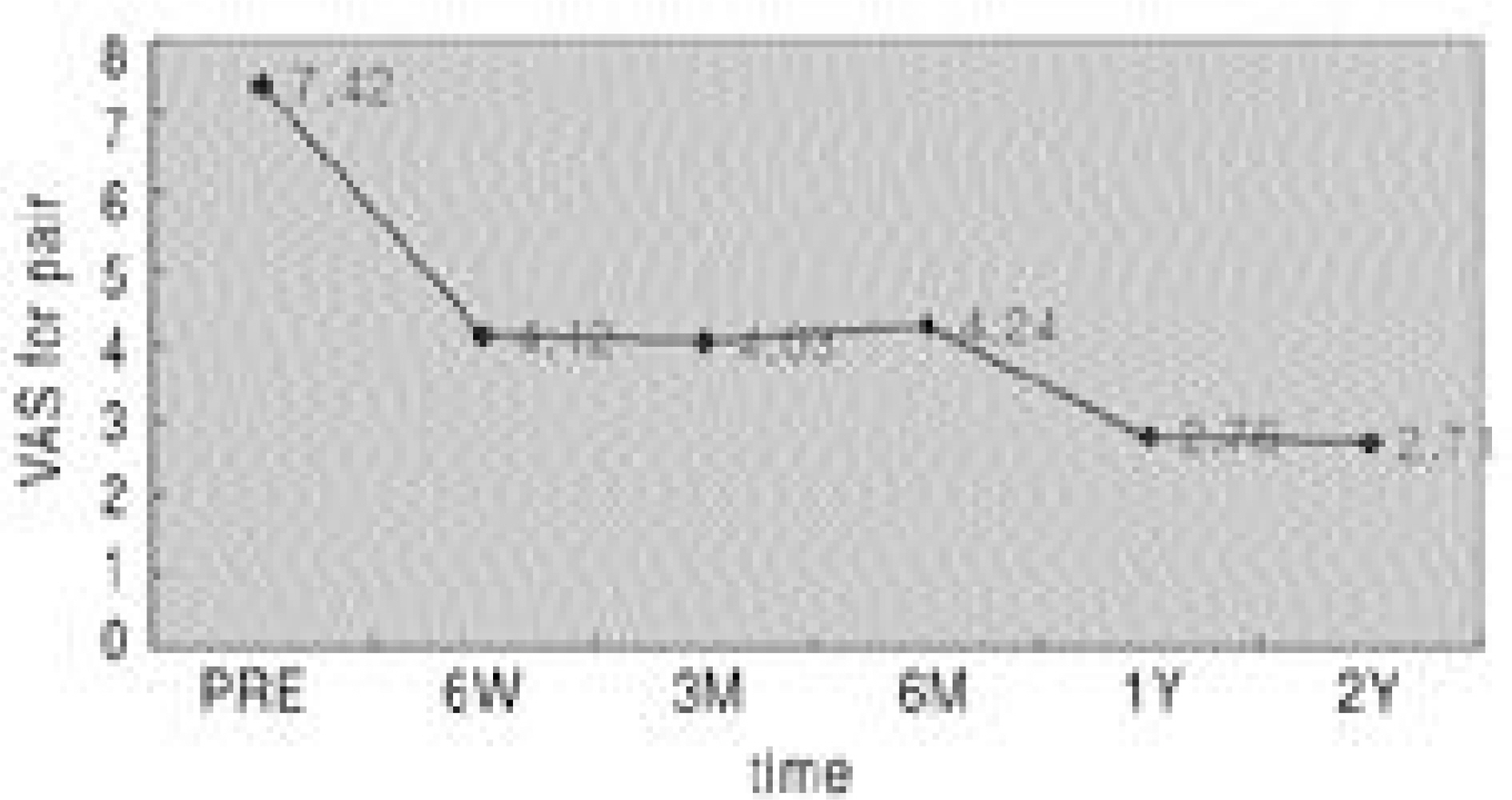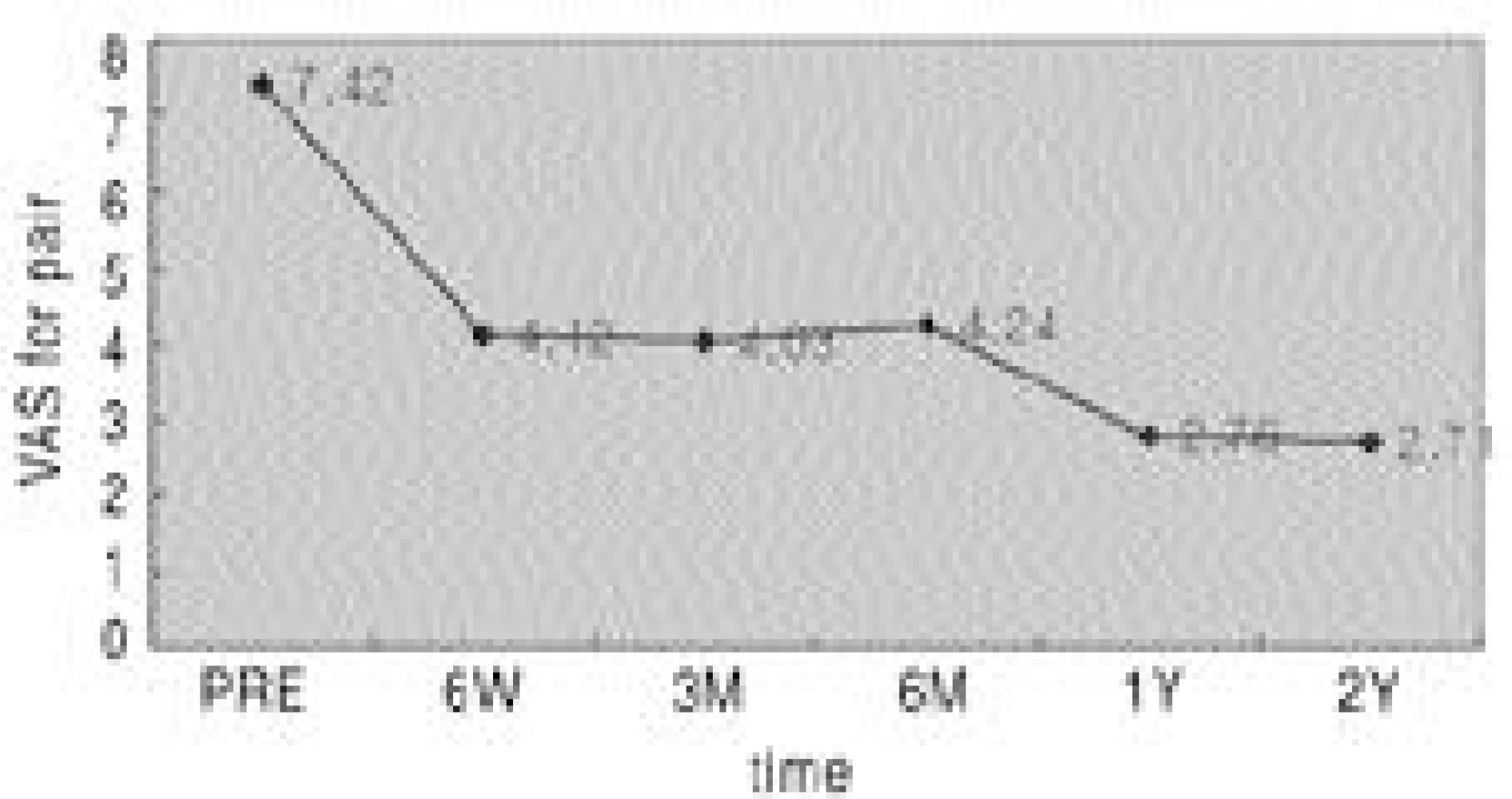Changes of Clinical Outcomes after Decompression and Fusion for Spinal Stenosis during 2-Year Follow-up Periods
- Affiliations
-
- 1Department of Orthopedic Surgery, College of Medicine, Inha Univercity, Incheon, Korea. jungcho@inha.ac.kr
- KMID: 2003208
- DOI: http://doi.org/10.4184/jkss.2003.10.2.113
Abstract
- STUDY DESIGN: A prospective study
OBJECTIVE
To assess the clinical outcomes after the surgical treatment of spinal stenosis, using patient-centered measurements at the serial follow-up times. SUMMARY OF LITERATURE REVIEW: Patient-centered measurements are appropriate to assess the clinical outcomes of surgery for spinal stenosis.
MATERIALS AND METHODS
Thirty-seven patients underwent posterior decompression and posterolateral fusion, with an iliac autograft using pedicle screw instrumentation. They were assessed for their pain using a visual analog scale, and the Oswestry disability index for the preoperative functional disability, at 6 weeks, 3 and 6 months, and at 1 and 2 years, postoperatively.
RESULTS
The pain, as measured by the visual analog scale, was 7.42 points before the operation, and 4.12 and 2.76 six weeks and 1 year after the operation, respectively. Compared with the pre-operation scores, 44% has improved after 6 weeks, and 73% after a year. The functional disability, as measured by the Oswestry disability index, was 56.5% before the operation, and 32.13 and 20.1% three months and 1 year after the operation. Compared with the pre-operation, 43% recovered after 3 months, and 65% after a year. The state of recovery state in the functional disability continued for 2 years after the operation. The disability recovered more slowly than the pain.
CONCLUSIONS
Patient-centered measurements were found to be appropriate for assessing the clinical outcomes to surgery for spinal stenosis. After decompression and fusion for spinal stenosis, the pain and functional disability both improved for 1 year after the operation, with no worsening in the postoperative improvements at 2 years.
Keyword
MeSH Terms
Figure
Cited by 4 articles
-
Lumbar Lordosis Restoration with an Eight Degree Cage in Posterior Lumbar Interbody Fusion for Lumbar Degenerative Disease
Young-Tae Kim, Kyu-Jung Cho, Ju-Yong Park, Jong-Hyuk Yang
J Korean Orthop Assoc. 2014;49(3):177-184. doi: 10.4055/jkoa.2014.49.3.177.Comparison of the Results of the Decompression Methods for Degenerative Lumbar Spinal Stenosis: Comparison of Posterior Element Saving Procedures
Jae-Won You, Hong-Moon Sohn, Ja-Yong Lee, Kyung-Ho Yang
J Korean Soc Spine Surg. 2005;12(4):324-330. doi: 10.4184/jkss.2005.12.4.324.Clinical Value of Nerve Root Sedimentation Sign in Lumbar Spinal Stenosis
Hyeon Jun Kim, Kyu Yeol Lee, Woo Chul Kim, Yong Seung Oh
J Korean Soc Spine Surg. 2011;18(3):117-122. doi: 10.4184/jkss.2011.18.3.117.Efficacy of Posterior Lumbar Interbody Fusion using PEEK Cage and Pedicle Screw Stabilization in Degenerative Lumbar Spinal Disorders - Minimum 3 Years Follow up Results –
Kyung-Jin Song, Kwang-Bok Lee, Dong-Hun Ham
J Korean Soc Spine Surg. 2011;18(4):230-238. doi: 10.4184/jkss.2011.18.4.230.
Reference
-
1). Amundsen T., Weber H., Lilleas F., Nordal HJ., Abdel-nour M., Magnaes B. Lumbar spinal stenosis: Clini -cal and radiologic features. Spine,. 20:1178–1186. 1995.2). Amundsen T., Weber H., Nordal H., Magnaes B., Abdel-noor M., Lilleas F. Lumbar spinal stenosis. Conservative or surgical management? A prospective 10-year study. Spine,. 11:1424–1436. 2000.3). Atlas SJ., Deyo RA., Keller RB., Chapin AM., Patrick DL., Long JM., Singer DE. The Maine lumbar spine study, part III. 1-year outcomes of surgical and nonsurgi -cal management of lumbar spinal stenosis. Spine,. 21:1787–1795. 1996.4). Atlas SJ., Keller RB., Robson D., Deyo RA., Singer DE. Surgical and nonsurgical management of lumbar spinal stenosis. Four-year outcomes from the Maine lum -bar spine study. Spine,. 25:556–562. 2000.5). Bombardier C. Outcome assessments in the evaluation of treatment of spinal disorders. summary and general rec -ommendations. Spine,. 25:3100–3103. 2000.6). Fairbanks JCT., Pynsent PB. The Oswestry disability index, Spine,. 25:2940–2953. 2000.7). Grevitt M., Khazim R., Webb J., Mulholland R., Shep-perd J. The short form-36 health survey questionnaire in spine surgery. J Bone Joint Surg,. 79-B:48–52. 1997.
Article8). Herno A., Airaksinen O., Saari TO., Pitkanen M., Manni-nen H., Suomalainen O. Computed tomography findings 4 years after surgical management of lumbar spinal stenosis. No correlation with clinical outcome. Spine,. 24:2234–2239. 1999.9). Herno A., Saari T., Suomalainen O., Airaksinen O. The degree of decompressive relief and its relation to clin -ical outcome in patients undergoing surgery for lumbar spinal stenosis. Spine,. 24:1010–1014. 1999.10). Javid MJ., Hadar EJ. Long-term follow-up review of patients who underwent laminectomy for lumbar stenosis: A prospective study. J Neurosurg,. 89:1–7. 1998.
Article11). Katz JN., Lipson SJ., Chang LC., Levine SA., Fossel AH., Liang MH. Seven-to 10-year outcome of decompres -sive surgery for degenerative lumbar spinal stenosis. Spine,. 21:92–98. 1996.12). Katz JN., Lipson SJ., Larson MG., Mcinnes JM. The outcome of decompressive laminectomy for degenerative lumbar stenosis. J Bone Joint Surg,. 73-A:809–816. 1991.
Article13). Leclaire R., Blier F., Fortin L., Proulx R. A cross-sectional study comparing the Oswestry and Roland-Morris functional disability scales in two populations of patients with low back pain of different levels of severity. Spine,. 22:68–71. 1997.
Article14). Roland M., Fairbank J. The Roland-Morris disability questionnaire and the Oswestry disability questionnaire. Spine,. 25:3115–3124. 2000.15). Stucki G., Liang MH., Fossel AH., Katz JN. Relative responsiveness of condition-specific and generic health status measures in degenerative lumbar spinal stenosis. J Clin Epidemiol,. 48:1369–1378. 1995.
Article16). Tenhula J., Lenke LG., Bridwell KH., Gupta P., Riew D. Prospective functional evaluation of the surgical treat -ment of neurogenic claudication in patients with lumbar spinal stenosis. J Spinal Disorders,. 13:276–282. 2000.
- Full Text Links
- Actions
-
Cited
- CITED
-
- Close
- Share
- Similar articles
-
- A Comparison of the Clinical Outcomes of Decompression Alone and Fusion in Elderly Patients with Two-Level or More Lumbar Spinal Stenosis
- Changes of Clinical Outcomes after Decompression and Fusion for Spinal Stenosis during 2-Year Follow-up Periods
- Results of Decompression Alone in Patients with Lumbar Spinal Stenosis and Degenerative Spondylolisthesis: A Minimum 5-Year Follow-up
- The Results of Treatment of Multilevel Spinal Stenosis: Comparison of the results on the numbers of decompressed segments and types of bone graft
- A Comparison of Clinical Outcomes between Decompressive Lumbar Laminectomy Alone and with Arthrodesis in Degenerative Lumbar Spinal Stenosis




